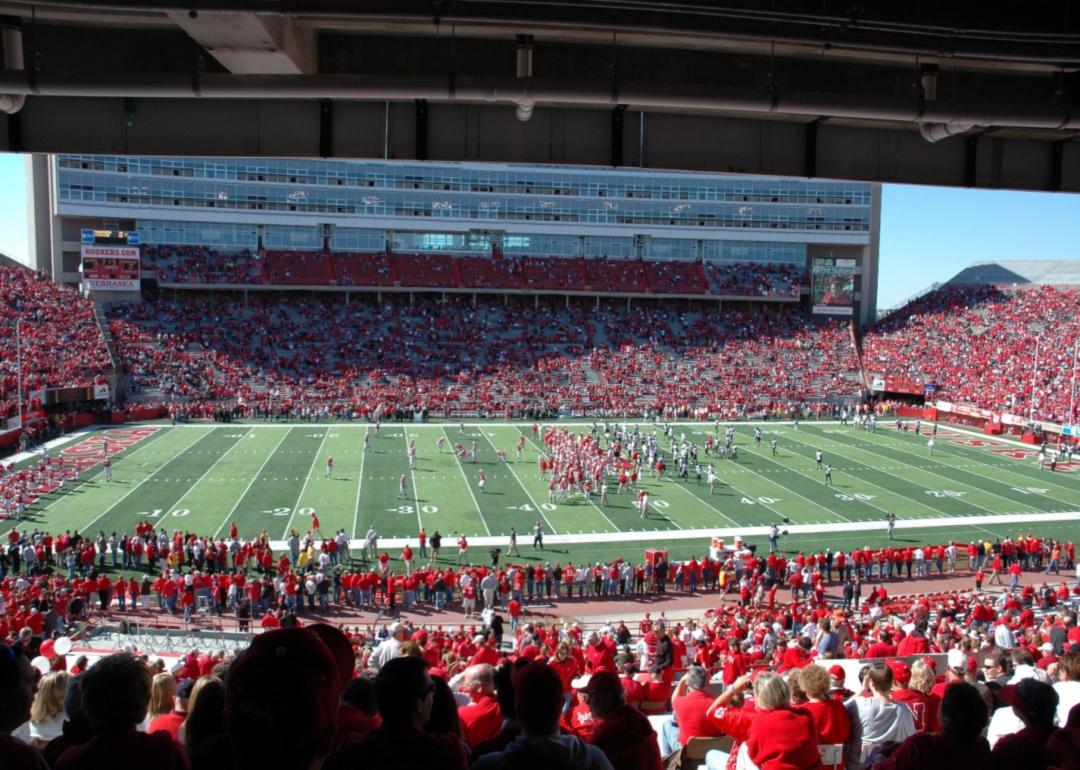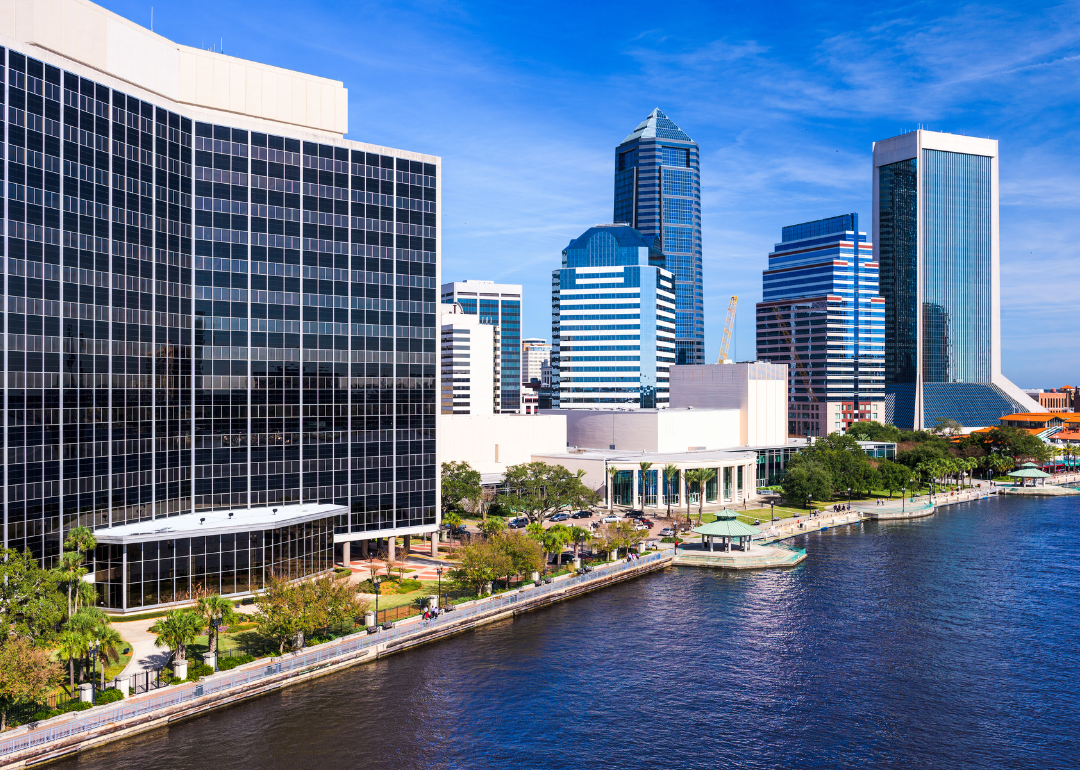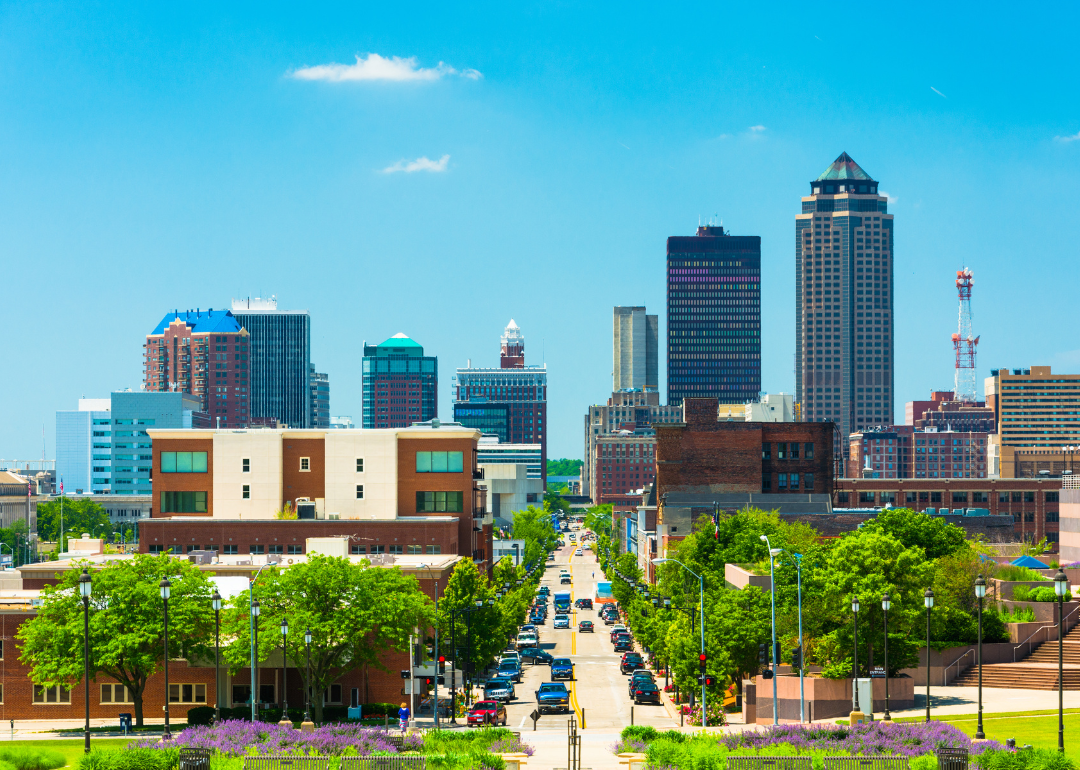Business
Best places for college grads to start their careers
Published
1 year agoon

Graduation season is around the corner, and college seniors across the country are applying for their first jobs. About 1 in 4 Americans 25 years or older have a bachelor’s degree or higher, and thousands will walk the stage this season to grab their diplomas and start their careers.
But choosing where to put down roots is about so much more than a role, especially as the rising popularity of remote work makes choosing a location more flexible. Graduates should consider the cost of living, social scene, potential income, and more.
Stacker analyzed data from the Labor Department, Census Bureau, and Apartment List to find which metro areas are the best for recent college graduates to start their careers. To be included, each metro needed a large share of residents with advanced degrees and a 2021 unemployment rate lower than or equal to the national average, which was 5.3%. Housing costs for young adults also had to be more affordable than the national average, measured as the ratio of the median income of households headed by people under 25 to the typical rent for a one-bedroom apartment. Metros were sorted by the median income of residents under 25, relative to the overall median income.
The median income for Americans under 25 was $38,164 in 2021, while the median rent for a one-bedroom apartment so far this year is $1,158. Considering experts recommend spending no more than 30% of your monthly income on rent, it’s critical to choose a location where the average cost of an apartment is low but the income prospects are high.
With these factors in mind, the metros on this list have stronger job markets and lower costs of living than major cities like New York, Chicago, or Atlanta.
You may also like: Youngest billionaires in America
![]()
Canva
#15. Omaha, Nebraska
– Median income of households headed by people under 25: $40,787
– Median rent for a 1-bedroom apartment: $962
– Unemployment rate: 3.0%
Omaha is home to many different industries for college grads to build their careers, housing major financial services corporations like TD Ameritrade and PayPal as well as health care companies like Methodist Health System and Blue Cross Blue Shield of Nebraska.
On top of a great cost of living, Omaha boasts a diverse food scene. You’ll get the steak and corn you’d expect, plus fine dining, pizza, seafood, and more.
Unlike many parts of the country, Omaha also experiences all four seasons, so while you’ll have to bear some cold temperatures in the winter, you’ll get to experience leaves changing in fall and warm summers.
rthoma // Shutterstock
#14. Lincoln, Nebraska
– Median income of households headed by people under 25: $36,205
– Median rent for a 1-bedroom apartment: $857
– Unemployment rate: 2.4%
Just over an hour south of Omaha is another top city for new grads: Lincoln. Though the city’s low unemployment rate and median rent are tempting enough, Nebraska’s capital also offers plenty of things to do.
Catch a Huskers game at the University of Nebraska, Lincoln, or tour one of the town’s many museums or parks. The Midwestern town is also host to a bustling live music scene.
Major employers include the University of Nebraska, Wells Fargo, IBM, and UnitedHealth Group.
Canva
#13. Fort Collins, Colorado
– Median income of households headed by people under 25: $45,126
– Median rent for a 1-bedroom apartment: $1,215
– Unemployment rate: 4.7%
An hour north of Denver, Fort Collins offers a much more affordable cost of living than its neighbor. The town is a great place for outdoor enthusiasts, thanks to its close proximity to hiking trails, ski resorts, and state parks. Beer lovers will also enjoy Fort Collins’ reputation as the craft beer capital of Colorado.
Fort Collins is emerging as a tech hub, in part due to employers like Hewlett-Packard. But other industries are hiring in the area, too, including companies such as OtterBox, Kaiser Permanente, and Colorado State University.
Canva
#12. Rochester, New York
– Median income of households headed by people under 25: $38,984
– Median rent for a 1-bedroom apartment: $1,017
– Unemployment rate: 4.9%
Situated on Lake Ontario, Rochester offers a low unemployment rate and cost of living compared to other parts of the state. Its economy is largely dependent on the technology and education sectors, but those aren’t the only ones hiring in the area. Major employers in Rochester include Paychex, Bausch & Lomb, Kodak, and the Rochester Institute of Technology.
Despite its cold climate, Rochester has plenty of natural beauty. The town is often called the “Flower City,” thanks to its year-round blooms, and it’s just a short drive from the famous Niagara Falls.
Canva
#11. Virginia Beach, Virginia
– Median income of households headed by people under 25: $42,904
– Median rent for a 1-bedroom apartment: $1,244
– Unemployment rate: 4.5%
Virginia Beach is situated at the intersection of the Chesapeake Bay and the Atlantic Ocean, making it an ideal choice for those who love the water. In addition to a boardwalk and plenty of beachside attractions, Virginia Beach offers an accessible cost of living for a coastal town.
The area is a hub for the Navy and other military operations, but other major employers include Geico, Sentara Healthcare, and Harmony Investments.
Canva
#10. Charlotte, North Carolina
– Median income of households headed by people under 25: $42,831
– Median rent for a 1-bedroom apartment: $1,284
– Unemployment rate: 4.6%
Charlotte is one of the fastest-growing metros in the U.S., and for good reason. Not only are the median income high and median rent low compared to the average, but it’s host to major sports teams, including the Carolina Panthers and Charlotte FC.
Charlotte is best known as a business and banking town, thanks to employers such as Bank of America and Wells Fargo. The town also plays host to headquarters for major tech companies, including Microsoft, Amazon, and IBM.
Grindstone Media Group // Shutterstock
#9. Indianapolis
– Median income of households headed by people under 25: $43,171
– Median rent for a 1-bedroom apartment: $978
– Unemployment rate: 3.5%
From the looming Lucas Oil Stadium to the Indianapolis Zoo or the Indy 500, there is no shortage of great places to spend a day in the capital of Indiana. And with a high median income and low median rent to boot, it can be a great choice for new grads looking for a bustling town to start their career.
Top employers in Indianapolis include Eli Lilly and Company, FedEx, AT&T, and Amazon.
Sundry Photography // Shutterstock
#8. San Jose, California
– Median income of households headed by people under 25: $86,632
– Median rent for a 1-bedroom apartment: $2,186
– Unemployment rate: 4.8%
Located in the heart of Silicon Valley, San Jose is far from the most affordable city on this list. But the town makes up for high rent costs with a significantly higher median income—making it attainable for the right person.
Like most of the Bay Area, San Jose boasts mild temperatures year-round. That, plus a diverse food scene and thriving nightlife, make the city an attractive choice for new grads.
Thanks to its central Silicon Valley location, San Jose is best known for tech companies, including Cisco, PayPal, and Adobe.
Canva
#7. Jacksonville, Florida
– Median income of households headed by people under 25: $43,282
– Median rent for a 1-bedroom apartment: $1,194
– Unemployment rate: 4.0%
Jacksonville is situated in the northeast corner of the state and is actually the most populous city in Florida. Its coastal location means plenty of beaches; in fact, Jacksonville boasts more shoreline than any other U.S. city.
Top employers in Jacksonville include Amazon, Baptist Health, Bank of America, and Mayo Clinic. Jobs span industries from financial services to life sciences, so there is something for everyone.
Canva
#6. Des Moines, Iowa
– Median income of households headed by people under 25: $46,972
– Median rent for a 1-bedroom apartment: $875
– Unemployment rate: 4.2%
Des Moines is a great pick for livability, thanks to its low cost of living as well as a short average commute and four distinct seasons. Locals can spend a day catching an Iowa Cubs game at Principal Park or sampling local vendors at the downtown farmers market.
The Midwestern town is host to large employers, including Wells Fargo, John Deere, UPS, and Tyson.
Steven Frame // Shutterstock
#5. Sioux Falls, South Dakota
– Median income of households headed by people under 25: $48,452
– Median rent for a 1-bedroom apartment: $847
– Unemployment rate: 2.8%
With the lowest median rent for a one-bedroom apartment on our list, Sioux Falls certainly delivers on affordability. Plus, South Dakota is one of only eight states without a state income tax, so residents will be able to keep more of their hard-earned money.
Sioux Falls is definitely a great choice for outdoor enthusiasts, with its parks and proximity to Big Sioux Recreation Area. Major employers in Sioux Falls include Sanford Health, Hy-Vee Food Stores, and Citi Bank.
Canva
#4. Boise, Idaho
– Median income of households headed by people under 25: $46,858
– Median rent for a 1-bedroom apartment: $1,032
– Unemployment rate: 3.5%
Boise is an up-and-coming tech hub, especially for startups, thanks to its quality of life. In addition to a low cost of living, Boise boasts plenty of outdoor adventures, diverse eateries, and a bustling live music scene.
It’s not just tech companies calling Boise home, either. Top employers include Albertsons, St. Luke’s Health System, and Winco.
Canva
#3. Honolulu
– Median income of households headed by people under 25: $58,827
– Median rent for a 1-bedroom apartment: $1,789
– Unemployment rate: 5.3%
The capital city of Hawaii has long been known as a tropical paradise. Though the median rent in Honolulu is higher than many other cities on our list, the town makes up for it with a higher median income and plenty of great reasons to make the island your home.
History buffs can tour Pearl Harbor; beach bums can catch some waves or dive to visit local wildlife; and foodies can sample local cuisine, from fresh seafood to spam musubi. Honolulu has a little something for everyone.
Top employers in Honolulu include the Hawaii State Department of Education, Hawaiian Airlines, and Hilton Hotels & Resorts.

Canva
#2. Crestview, Florida
– Median income of households headed by people under 25: $47,271
– Median rent for a 1-bedroom apartment: $1,120
– Unemployment rate: 3.4%
Located west of Tallahassee in the Florida Panhandle, Crestview is a lesser-known town with much to offer. Called “Hub City,” Crestview is situated on major highways, including Interstate 10, State Road 85, and U.S. Route 90, making it a prime starting location for nationwide travel. It’s one of the smaller towns on our list, so it’s a good choice for new grads looking for a slower pace.
Major employers in Crestview include L3Harris, Universal Health Services, and Food Giant.
Kristi Blokhin // Shutterstock
#1. Savannah, Georgia
– Median income of households headed by people under 25: $47,069
– Median rent for a 1-bedroom apartment: $1,297
– Unemployment rate: 3.9%
Savannah is well-known for its picturesque historic architecture and coastal locale. Packed with history and southern charm, Savannah is a great location for new college grads looking to balance an affordable cost of living with unique character. Its booming housing market also makes it a great place to put down roots.
The town is home to several colleges, including the Savannah College of Art and Design. The school is one of the city’s top employers, alongside large companies like Gulfstream Aerospace and Memorial Health.
Founded in 2017, Stacker combines data analysis with rich editorial context, drawing on authoritative sources and subject matter experts to drive storytelling.
You may like
Business
Cashiers vs. digital ordering: What do people want, and at what cost?
Published
2 days agoon
April 26, 2024
You walk into a fast-food restaurant on your lunch break. You don’t see a cashier but instead a self-service kiosk, a technology that is becoming the new norm in eateries across the country. The kiosks usually offer customers a menu to scroll through and pictures of meals and specials with prompts to select their food and submit their payment in one place.
Self-service kiosks are big business. In fact, the market for self-service products is expected to grow from a $40.3 billion market value in 2022 to $63 billion by 2027, according to a report from BCC Research. Consumers do have mixed opinions about the kiosks, but about 3 out of 5 surveyed consumers reported that they were likely to use self-service kiosks, according to the National Restaurant Association. The technology, while expensive, can boost businesses’ bottom lines in the long run.
Task Group summarized the rise in digital ordering over the past couple of years, its acceptance among customers, and a cost analysis of adopting the technology.
Self-service kiosks—digital machines or display booths—are generally placed in high-traffic areas. They can be used for different reasons, including navigating a store or promoting a product. Interactive self-service kiosks in particular are meant for consumers to place orders with little to no assistance from employees.
The idea of kiosks isn’t new. The concept of self-service was first introduced in the 1880s when the first types of kiosks appeared as vending machines selling items like gum and postcards. In the present age of technology, the trend of self-service has only grown. Restaurants such as McDonald’s and Starbucks have already tried out cashierless technology.
From a business perspective, the kiosks offer a huge upside. While many employers are looking for workers, they’re having a hard time finding staff. In the midst of the COVID-19 pandemic, employers struggled with a severe employee shortage. Since then, the problem has continued. In 2022, the National Restaurant Association reported that 65% of restaurant operators didn’t have enough workers on staff to meet consumer demand. With labor shortages running rampant, cashierless technology could help restaurants fill in for the lack of human employees.
The initial investment for the kiosks can be high. The general cost per kiosk is difficult to quantify, with one manufacturer estimating a range of $1,500 to $20,000 per station. However, with the use of kiosks, restaurants may not need as many cashiers or front-end employees, instead reallocating workers’ time to other tasks.
In May 2022, the hourly mean wage for cashiers who worked in restaurants and other eating establishments was $12.99, according to the Bureau of Labor Statistics. Kiosks could cost less money than a cashier in the long run.
But how do the customers themselves feel about the growing trend? According to a Deloitte survey, 62% of respondents report that they were “somewhat likely” to order from a cashierless restaurant if given the chance to do so. The same survey reported that only 19% of respondents had experience with a cashierless restaurant.
What would it mean for society if restaurants did decide to go completely cashierless? Well, millions of positions would likely no longer be necessary. One report suggests 82% of restaurant positions could be replaced by robots, a prospect making automation appealing to owners who can’t find staff to hire.
Due to the ongoing labor shortage, employers have tried raising employee wages. Papa John’s, Texas Roadhouse, and Chipotle were among the restaurant companies that increased employee pay or offered bonuses in an attempt to hire and retain more workers. Meanwhile, some companies have decided to use technology to perform those jobs instead, so that they wouldn’t have to put effort into hiring or focus their existing staff on other roles.
Story editing by Ashleigh Graf and Jeff Inglis. Copy editing by Tim Bruns.
![]()
Founded in 2017, Stacker combines data analysis with rich editorial context, drawing on authoritative sources and subject matter experts to drive storytelling.

It’s well-documented that the surest, and often best, return on investments comes from playing the long game. But between stocks and real estate, which is the stronger bet?
To find out, financial planning firm Wealth Enhancement Group analyzed data from academic research, Standard and Poor’s, and Nareit to see how real estate compares to stocks as an investment.
Data going back to 1870 shows the well-established power of real estate as a powerful “long-run investment.” From 1870-2015, and after adjusting for inflation, real estate produced an average annual return of 7.05%, compared to 6.89% for equities. These findings, published in the 2019 issue of The Quarterly Journal of Economics, illustrate that stocks can deviate as much as 22% from their average, while housing only spreads out 10%. That’s because despite having comparable returns, stocks are inherently more volatile due to following the whims of the business cycle.
Real estate has inherent benefits, from unlocking cash flow and offering tax breaks to building equity and protecting investors from inflation. Investments here also help to diversify a portfolio, whether via physical properties or a real estate investment trust. Investors can track markets with standard resources that include the S&P CoreLogic Case-Shiller Home Price Indices, which tracks residential real estate prices; the Nareit U.S. Real Estate Index, which gathers data on the real estate investment trust, or REIT, industry; and the S&P 500, which tracks the stocks of 500 of the largest companies in the U.S.
High interest rates and a competitive market dampened the flurry of real-estate investments made in the last four years. The rise in interest rates equates to a bigger borrowing cost for investors, which can spell big reductions in profit margins. That, combined with the risk of high vacancies, difficult tenants, or hidden structural problems, can make real estate investing a less attractive option—especially for first-time investors.
Keep reading to learn more about whether real estate is a good investment today and how it stacks up against the stock market.
![]()

Wealth Enhancement Group
Stocks and housing have both done well
REITs can offer investors the stability of real estate returns without bidding wars or hefty down payments. A hybrid model of stocks and real estate, REITs allow the average person to invest in businesses that finance or own income-generating properties.
REITs delivered slightly better returns than the S&P 500 over the past 20-, 25-, and 50-year blocks. However, in the short term—the last 10 years, for instance—stocks outperformed REITs with a 12% return versus 9.5%, according to data compiled by The Motley Fool investor publication.
Whether a new normal is emerging that stocks will continue to offer higher REITs remains to be seen.
This year, the S&P 500 reached an all-time high, courtesy of investor enthusiasm in speculative tech such as artificial intelligence. However, just seven tech companies, dubbed “The Magnificent 7,” are responsible for an outsized amount of the S&P’s returns last year, creating worry that there may be a tech bubble.
While indexes keep a pulse on investment performance, they don’t always tell the whole story. The Case-Shiller Index only measures housing prices, for example, which leaves out rental income (profit) or maintenance costs (loss) when calculating the return on residential real estate investment.

Wealth Enhancement Group
Housing returns have been strong globally too
Like its American peers, the global real estate market in industrialized nations offers comparable returns to the international stock market.
Over the long term, returns on stocks in industrialized nations is 7%, including dividends, and 7.2% in global real estate, including rental income some investors receive from properties. Investing internationally may have more risk for American buyers, who are less likely to know local rules and regulations in foreign countries; however, global markets may offer opportunities for a higher return. For instance, Portugal’s real estate market is booming due to international visitors deciding to move there for a better quality of life. Portugal’s housing offers a 6.3% return in the long term, versus only 4.3% for its stock market.
For those with deep enough pockets to stay in, investing in housing will almost always bear out as long as the buyer has enough equity to manage unforeseen expenses and wait out vacancies or slumps in the market. Real estate promises to appreciate over the long term, offers an opportunity to collect rent for income, and allows investors to leverage borrowed capital to increase additional returns on investment.
Above all, though, the diversification of assets is the surest way to guarantee a strong return on investments. Spreading investments across different assets increases potential returns and mitigates risk.
Story editing by Nicole Caldwell. Copy editing by Paris Close. Photo selection by Lacy Kerrick.
This story originally appeared on Wealth Enhancement Group and was produced and
distributed in partnership with Stacker Studio.
Founded in 2017, Stacker combines data analysis with rich editorial context, drawing on authoritative sources and subject matter experts to drive storytelling.
Business
5 tech advancements sports venues have added since your last event
Published
1 week agoon
April 19, 2024
In today’s digital climate, consuming sports has never been easier. Thanks to a plethora of streaming sites, alternative broadcasts, and advancements to home entertainment systems, the average fan has myriad options to watch and learn about their favorite teams at the touch of a button—all without ever having to leave the couch.
As a result, more and more sports venues have committed to improving and modernizing their facilities and fan experiences to compete with at-home audiences. Consider using mobile ticketing and parking passes, self-service kiosks for entry and ordering food, enhanced video boards, and jumbotrons that supply data analytics and high-definition replays. These innovations and upgrades are meant to draw more revenue and attract various sponsored partners. They also deliver unique and convenient in-person experiences that rival and outmatch traditional ways of enjoying games.
In Los Angeles, the Rams and Chargers’ SoFi Stadium has become the gold standard for football venues. It’s an architectural wonder with closer views, enhanced hospitality, and a translucent roof that cools the stadium’s internal temperature.
The Texas Rangers’ ballpark, Globe Life Field, added field-level suites and lounges that resemble the look and feel of a sports bar. Meanwhile, the Los Angeles Clippers are building a new arena (in addition to retail space, team offices, and an outdoor public plaza) that will seat 18,000 people and feature a fan section called The Wall, which will regulate attire and rooting interest.
It’s no longer acceptable to operate with old-school facilities and technology. Just look at Commanders Field (formerly FedExField), home of the Washington Commanders, which has faced criticism for its faulty barriers, leaking ceilings, poor food options, and long lines. Understandably, the team has been attempting to find a new location to build a state-of-the-art stadium and keep up with the demand for high-end amenities.
As more organizations audit their stadiums and arenas and keep up with technological innovations, Uniqode compiled a list of the latest tech advancements to coax—and keep—fans inside venues.
![]()
Jeff Gritchen/MediaNews Group/Orange County Register // Getty Images
Just Walk Out technology
After successfully installing its first cashierless grocery store in 2020, Amazon has continued to put its tracking technology into practice.
In 2023, the Seahawks incorporated Just Walk Out technology at various merchandise stores throughout Lumen Field, allowing fans to purchase items with a swipe and scan of their palms.
The radio-frequency identification system, which involves overhead cameras and computer vision, is a substitute for cashiers and eliminates long lines.
RFID is now found in a handful of stadiums and arenas nationwide. These stores have already curbed checkout wait times, eliminated theft, and freed up workers to assist shoppers, according to Jon Jenkins, vice president of Just Walk Out tech.
Billie Weiss/Boston Red Sox // Getty Images
Self-serve kiosks
In the same vein as Amazon’s self-scanning technology, self-serve kiosks have become a more integrated part of professional stadiums and arenas over the last few years. Some of these function as top-tier vending machines with canned beers and nonalcoholic drinks, shuffling lines quicker with virtual bartenders capable of spinning cocktails and mixed drinks.
The kiosks extend past beverages, as many college and professional venues have started using them to scan printed and digital tickets for more efficient entrance. It’s an effort to cut down lines and limit the more tedious aspects of in-person attendance, and it’s led various competing kiosk brands to provide their specific conveniences.
Kyle Rivas // Getty Images
Mobile ordering
Is there anything worse than navigating the concourse for food and alcohol and subsequently missing a go-ahead home run, clutch double play, or diving catch?
Within the last few years, more stadiums have eliminated those worries thanks to contactless mobile ordering. Fans can select food and drink items online on their phones to be delivered right to their seats. Nearly half of consumers said mobile app ordering would influence them to make more restaurant purchases, according to a 2020 study at PYMNTS. Another study showed a 22% increase in order size.
Many venues, including Yankee Stadium, have taken notice and now offer personalized deliveries in certain sections and established mobile order pick-up zones throughout the ballpark.
Darrian Traynor // Getty Images
QR codes at seats
Need to remember a player’s name? Want to look up an opponent’s statistics at halftime? The team at Digital Seat Media has you covered.
Thus far, the company has added seat tags to more than 50 venues—including two NFL stadiums—with QR codes to promote more engagement with the product on the field. After scanning the code, fans can access augmented reality features, look up rosters and scores, participate in sponsorship integrations, and answer fan polls on the mobile platform.
Boris Streubel/Getty Images for DFL // Getty Images
Real-time data analytics and generative AI
As more venues look to reinvigorate the in-stadium experience, some have started using generative artificial intelligence and real-time data analytics. Though not used widely yet, generative AI tools can create new content—text, imagery, or music—in conjunction with the game, providing updates, instant replays, and location-based dining suggestions
Last year, the Masters golf tournament even began including AI score projections in its mobile app. Real-time data is streamlining various stadium pitfalls, allowing operation managers to monitor staffing issues at busy food spots, adjust parking flows, and alert custodians to dirty or damaged bathrooms. The data also helps with security measures. Open up an app at a venue like the Honda Center in Anaheim, California, and report safety issues or belligerent fans to help better target disruptions and preserve an enjoyable experience.
Story editing by Nicole Caldwell. Copy editing by Paris Close. Photo selection by Lacy Kerrick.
This story originally appeared on Uniqode and was produced and
distributed in partnership with Stacker Studio.
Founded in 2017, Stacker combines data analysis with rich editorial context, drawing on authoritative sources and subject matter experts to drive storytelling.
Featured
-

 Business4 months ago
Business4 months agoSkill-based hiring is the answer to labour shortages, BCG report finds
-

 Business5 months ago
Business5 months agomesh conference goes deep on AI, with experts focusing in on training, ethics, and risk
-

 Events3 months ago
Events3 months agoThe Northern Lights Technology & Innovation Forum comes to Calgary next month
-

 People4 months ago
People4 months agoHow connected technologies trim rework and boost worker safety in hands-on industries
-

 Events6 months ago
Events6 months agoTop 5 tech and digital transformation events to wrap up 2023




















